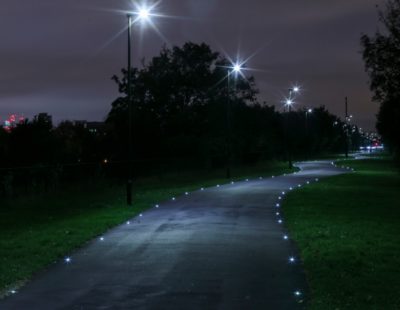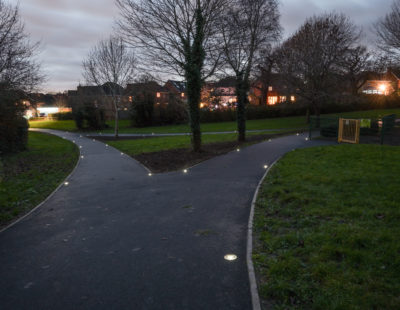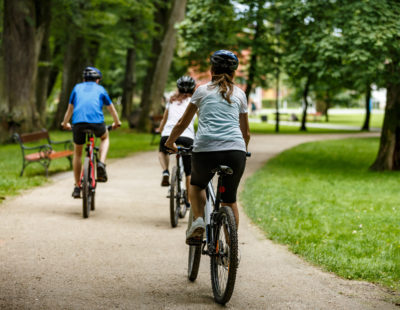Illuminating pathways with solar lighting is worth the money when comparing it against traditional lighting, thanks to numerous environmental, budgetary and time-related benefits. From cycle paths, to city walkways, to riverside paths, Solareye80 solar powered ground lights have been used across the globe to guide path users, and illuminate the way.
Solar lighting is an eco-friendly solution that is increasingly becoming more popular, however there are still those who don’t know the benefits of solar lighting and how to make the most of it. Below, our expert team at Solareye help you make the most of your outdoor solar path lights.
Still unsure on which outdoor lighting solution is best for paths? Read our guide to understanding the best options for public outdoor lighting.
See more: The Ultimate Guide to Ground Lighting
Outdoor solar path light considerations
Positioning
Each path is different in length, width and usage as well as some being straight and some winding through the landscape. Therefore, each path lighting design should be different too. Over the years, we’ve seen all sorts of path light designs, from single line central spacing, to alternating zig-zag patterns and lining the edges in pairs (see examples on our case studies page).
To make the most of your ground solar lights, it’s worth considering how they would be best positioned. With aesthetics and use in mind, the best solar lighting for one path may be entirely different from another. Cycle paths, for example, suit having a line of lights down the centre as this acts as a separator for sides, helping to keep users coming from different directions on different sides. Whereas a path through a city may prefer to have lights lining the edge of the path, so people know where the ground may become uneven – the safety of cyclists and pedestrians is always vital.
If you aren’t sure about where to position your solar ground lights, we have a handy downloadable guide to spacing – or get in touch with our team who will be able to discuss your project and help you reach a decision on the best design for your application.
Occasional cleaning
All outdoor lighting, whether it is solar or traditional, will need cleaning and maintaining every now and then. Doing this will help your solar lights function and illuminate properly by ensuring they are not covered by dirt or debris allowing them to fully harness the energy from the sun.
Fortunately, Solareye80 solar lights do not require regular cleaning, and can certainly be deemed a ‘low maintenance’ lighting option. The nature of their design means they sit flush to the ground therefore passing shoes and bike tyres do much of the work in keeping them free of dirt and debris.
If you are concerned about charging conditions – be it from debris or weather – you needn’t be; Solareye80 solar ground lights will illuminate for 200+ hours from a full charge, meaning they are capable of continuing to work for several nights without receiving any additional charge.
View the technical specification >
Explore colour and light options
Did you know we offer a range of colour and LED signal options for our solar ground lights? Not all path lights have to be the same! In fact, you can choose from white, red, yellow, green, blue or warm white (2,700k – as recommended by the International Dark Sky Association) lights with the option of continuous or flashing LEDs.
This can instantly elevate your path lighting; think red lights near roads, gates, steps, bridges etc. to alert people to potential hazards. It may be that for your path, a different colour or flashing light would be best, so it’s important to get the units that best suit the application.
Got something in mind? Get in touch with us to discuss your idea!
Maximise the solar panels’ exposure to the sun
It is important to ensure that any plant, tree or shrubs which may be in the way of sunlight reaching the panels is kept trimmed back to maximise exposure. For paths lined with vegetation, caution must be taken to ensure the lights do not become buried under fallen leaves or creeping plant life, however in this case we may recommend central spacing or installing your solar ground lights a safe distance in from the path’s edge.
The occasional bit of shading shouldn’t be a problem, but permanent obstructions to sunlight would reduce the effectiveness of any solar light. Something to consider if your path does have covered areas could be solar roof lights. Bus shelters, for example, offer a sheltered place for people to wait, but without light they can be unwelcoming at night. Though ground lights might not be suitable for this application, Solareye Roof Lights can be easily installed, creating an inviting shelter for people to use when close to the path.
Proper installation
Installing Solareye80 ground lights is easy and requires minimal equipment. Most installations can be done without needing to close the path to the public, and an experienced two-person team can install circa 200 lights in one day. It is, however, important that installation is done correctly and well to ensure longevity. Furthermore, the material construction of the path dictates the installation method required, all of which we are happy to advise on.
For customers wishing to install Solareye80 solar ground lights into asphalt pathways themselves, we’ve put together a helpful installation video to show how it is done. We also sell all of the equipment required so you can ensure your team have everything they need for an efficient and successful installation.
Outdoor solar path lighting with Solareye
Ready to enhance your paths with eco-friendly ground lighting? We are solar lighting experts, specialising in eco-friendly ground lighting. With an estimated lifespan of more than 8+ years, extremely low maintenance, and simple wireless installation, our solar ground lighting units make the perfect long-term solution for paths around the world.
Contact our team to get started!





